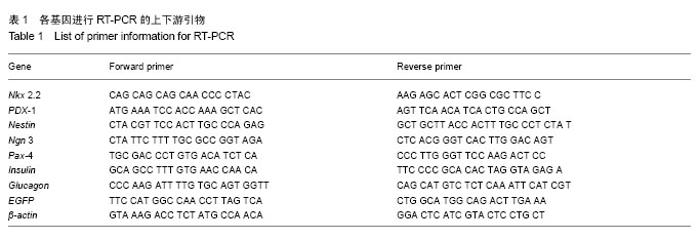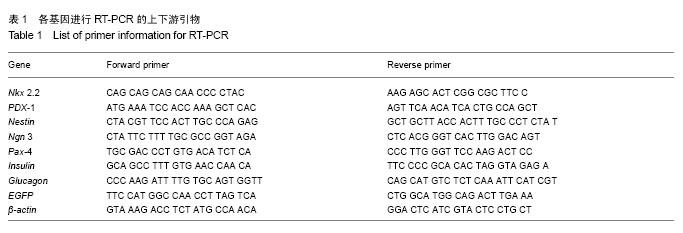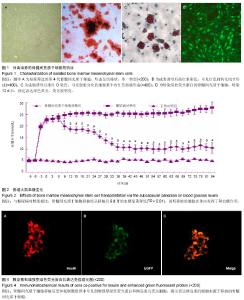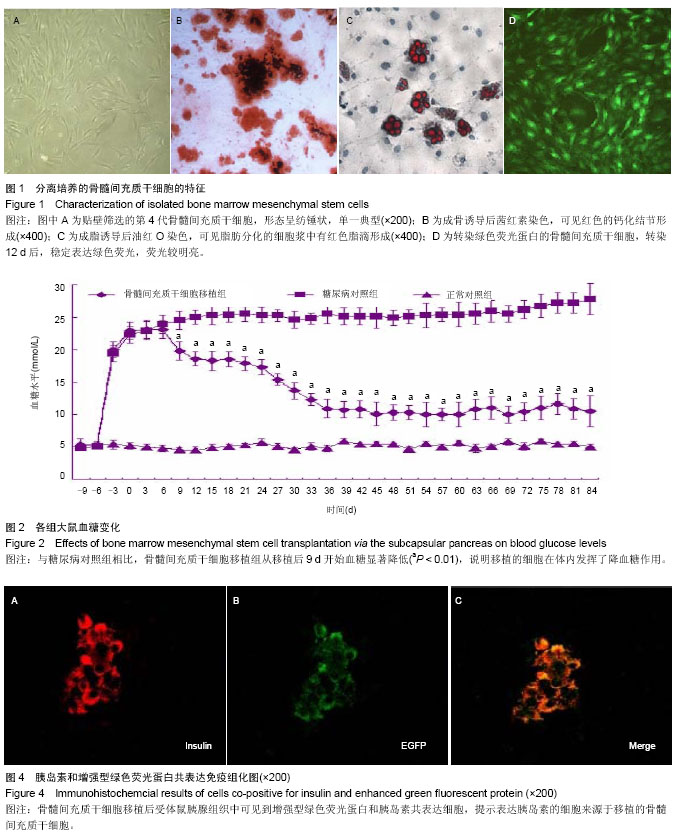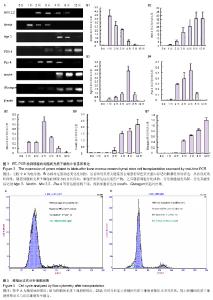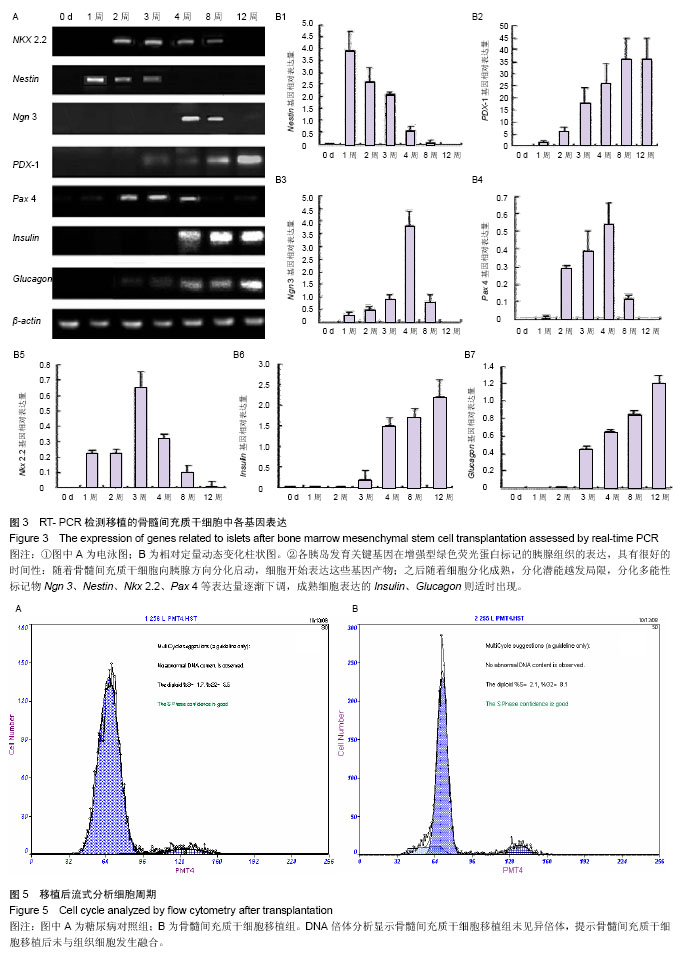Chinese Journal of Tissue Engineering Research ›› 2014, Vol. 18 ›› Issue (32): 5158-5165.doi: 10.3969/j.issn.2095-4344.2014.32.013
Previous Articles Next Articles
Bone marrow mesenchymal stem cell transplantation for treatment of diabetes: “transdifferantiation” appears?
Chen Chu-xian, Ren Li-li, Jiang Jin-xing, Zhang Jie-jie, Ye Li-zi, Li Fu-rong, Deng Chun-yan
- Biotherapy Laboratory, Key Laboratory of Stem Cells and Cellular Therapy, Shenzhen People’s Hospital, the Second Clinical Medical College of Jinan University, Shenzhen 518020, Guangdong Province, China
-
Received:2014-06-29Online:2014-08-06Published:2014-09-18 -
Contact:Deng Chun-yan, Master, Associate chief technician, Biotherapy Laboratory, Key Laboratory of Stem Cells and Cellular Therapy, Shenzhen People’s Hospital, the Second Clinical Medical College of Jinan University, Shenzhen 518020, Guangdong Province, China -
About author:Chen Chu-xian, Nurse in charge, Biotherapy Laboratory, Key Laboratory of Stem Cells and Cellular Therapy, Shenzhen People’s Hospital, the Second Clinical Medical College of Jinan University, Shenzhen 518020, Guangdong Province, China -
Supported by:the Science and Technology Plan of Shenzhen City, No. 201102163, 201302024
CLC Number:
Cite this article
Chen Chu-xian, Ren Li-li, Jiang Jin-xing, Zhang Jie-jie, Ye Li-zi, Li Fu-rong, Deng Chun-yan. Bone marrow mesenchymal stem cell transplantation for treatment of diabetes: “transdifferantiation” appears? [J]. Chinese Journal of Tissue Engineering Research, 2014, 18(32): 5158-5165.
share this article
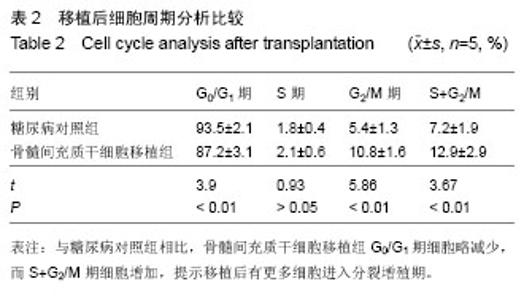
2.2 移植后血糖变化 正常SD大鼠空腹血糖恒定在5.0-5.5 mmol/L,无自发性高血糖;使用链脲佐菌素造模成功大鼠血糖进行性升高,全程血糖都在22.3 mmol/L以上;移植组骨髓间充质干细胞移植9 d后血糖降至(19.8± 2.5) mmol/L,与糖尿病对照组比差异有显著性意义(P < 0.05),之后血糖持续降低,到移植后36 d血糖降低至(10.9±2.3) mmol/L,接近正常鼠血糖水平,监测到移植后84 d,血糖基本稳定在(10.5±2.5) mmol/L水平,与糖尿病对照组比较有显著降低(P < 0.001),见图2。 2.3 移植细胞胰岛发育关键基因的表达 至移植后12周,胰腺组织中移植细胞的标记物增强型绿色荧光蛋白基本稳定表达,K值波动不大。移植后1周,检测到增强型绿色荧光蛋白阳性细胞中PDX-1,Ngn 3,Pax 4和Nkx 2.2有微量水平的表达,Nestin的表达迅速到达峰值,随后逐渐下降;Nkx 2.2的表达在移植后3周达峰值;Pax 4和Ngn 3的表达在移植后4周到达峰值;胰岛素和胰高血糖素表达在移植后3周开始增加,至移植后12周到达峰值;PDX-1的表达在8周时达到峰值并维持至12周,而Nkx 2.2、Nestin、Ngn 3、Pax 4的表达在12周时则下调到最低水平,见图3。 2.4 免疫荧光组织化学染色观察 荧光免疫组织化学染色提示骨髓间充质干细胞移植后受体鼠胰腺组织中可见到增强型绿色荧光蛋白和胰岛素共表达细胞(图4),约占胰岛素阳性细胞的5%。 2.5 移植细胞的DNA倍体分析 与未进行细胞移植的糖尿病对照组相比,骨髓间充质干细胞移植后的胰腺组织中G0/G1期细胞略减少,而处于分裂增殖期的细胞(S+G2/M)增加,差异有显著性意义(表2及图5),且未见异倍体。"
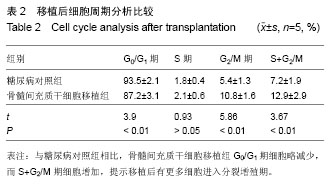
| [1] Soria B, Skoudy A, Martín F.From stem cells to beta cells: new strategies in cell therapy of diabetes mellitus. Diabetologia. 2001;44(4):407-415. [2] Shapiro AM, Lakey JR, Ryan EA, et al. Islet transplantation in seven patients with type 1 diabetes mellitus using a glucocorticoid-free immunosuppressive regimen.N Engl J Med. 2000;343(4):230-238. [3] Wen Y, Chen B, Ildstad ST.Stem cell-based strategies for the treatment of type 1 diabetes mellitus.Expert Opin Biol Ther. 2011;11(1):41-53. [4] Ianus A, Holz GG, Theise ND,et al. In vivo derivation of glucose-competent pancreatic endocrine cells from bone marrow without evidence of cell fusion.J Clin Invest. 2003; 111(6):843-850. [5] Neshati Z, Matin MM, Bahrami AR,et al. Differentiation of mesenchymal stem cells to insulin-producing cells and their impact on type 1 diabetic rats.J Physiol Biochem. 2010;66(2): 181-187. [6] Tang DQ, Cao LZ, Burkhardt BR,et al. In vivo and in vitro characterization of insulin-producing cells obtained from murine bone marrow.Diabetes. 2004;53(7):1721-1732. [7] Limbert C, Päth G, Jakob F,et al. Beta-cell replacement and regeneration: Strategies of cell-based therapy for type 1 diabetes mellitus.Diabetes Res Clin Pract. 2008;79(3): 389-99. [8] Moore KA, Lemischka IR.Stem cells and their niches.Science. 2006;311(5769):1880-1885. [9] Chang C, Niu D, Zhou H,et al. Mesenchymal stem cells contribute to insulin-producing cells upon microenvironmental manipulation in vitro.Transplant Proc. 2007;39(10):3363- 3368. [10] Gabr MM, Zakaria MM, Refaie AF,et al.Insulin-producing cells from adult human bone marrow mesenchymal stem cells control streptozotocin-induced diabetes in nude mice.Cell Transplant. 2013;22(1):133-145. [11] Choi KS, Shin JS, Lee JJ, et al. In vitro trans-differentiation of rat mesenchymal cells into insulin-producing cells by rat pancreatic extract.Biochem Biophys Res Commun. 2005; 330(4):1299-1305. [12] Ai C, Todorov I, Slovak ML,et al. Human marrow-derived mesodermal progenitor cells generate insulin-secreting islet-like clusters in vivo.Stem Cells Dev. 2007;16(5):757- 770. [13] 杨亚丽,高峰,齐晖,等.骨髓间充质干细胞移植入糖尿病大鼠胰腺后的分化及对血糖的影响[J].基础医学与临床,2009, 29(6): 584-588. [14] 高峰,周汉新,齐晖,等.骨髓间充质干细胞胰腺包膜下移植与静脉移植治疗大鼠糖尿病的效果比较[J].中国组织工程研究与临床康复,2009,13(19):3675-3679. [15] Terada N, Hamazaki T, Oka M, et al. Bone marrow cells adopt the phenotype of other cells by spontaneous cell fusion. Nature. 2002;416(6880):542-545. [16] Ying QL, Nichols J, Evans EP,et al. Changing potency by spontaneous fusion.Nature. 2002;416(6880):545-548. [17] Xu YX, Chen L, Wang R, et al. Mesenchymal stem cell therapy for diabetes through paracrine mechanisms.Med Hypotheses. 2008;71(3):390-393. [18] 范子扬,白金宝,王辉,等. 骨髓间充质干细胞促进胰岛再生的作用与研究现状[J].中国组织工程研究,2013,17(1):118-123. [19] 邓春艳,李富荣,王新根,等.小鼠骨髓间充质干细胞减轻胰岛移植物排斥反应的作用[J].中华器官移植杂志,2010,31(9):553-557. [20] Najafi R, Sharifi AM.Deferoxamine preconditioning potentiates mesenchymal stem cell homing in vitro and in streptozotocin-diabetic rats.Expert Opin Biol Ther. 2013;13(7): 959-972. [21] Tsai PJ, Wang HS, Lin CH,et al. Intraportal injection of insulin-producing cells generated from human bone marrow mesenchymal stem cells decreases blood glucose level in diabetic rats.Endocr Res. 2014;39(1):26-33. [22] Hao H, Liu J, Shen J,et al. Multiple intravenous infusions of bone marrow mesenchymal stem cells reverse hyperglycemia in experimental type 2 diabetes rats.Biochem Biophys Res Commun. 2013;436(3):418-423. [23] Chhabra P, Brayman KL.Stem cell therapy to cure type 1 diabetes: from hype to hope.Stem Cells Transl Med. 2013; 2(5):328-336. [24] Choi JB, Uchino H, Azuma K,et al. Little evidence of transdifferentiation of bone marrow-derived cells into pancreatic beta cells.Diabetologia. 2003;46(10):1366-1374. [25] Urbán VS, Kiss J, Kovács J,et al.Mesenchymal stem cells cooperate with bone marrow cells in therapy of diabetes.Stem Cells. 2008;26(1):244-253. [26] 程愈,申晶,郝好杰,等.骨髓间充质干细胞移植促进糖尿病大鼠β细胞再生的机制[J]. 解放军医学院学报,2013,34(6):610-613. [27] Heller RS, Jenny M, Collombat P,et al. Genetic determinants of pancreatic epsilon-cell development.Dev Biol. 2005; 286(1): 217-224. [28] Watada H.Neurogenin 3 is a key transcription factor for differentiation of the endocrine pancreas.Endocr J. 2004; 51(3):255-264. [29] Rukstalis JM, Habener JF.Neurogenin3: a master regulator of pancreatic islet differentiation and regeneration.Islets. 2009; 1(3):177-184. [30] Oliver-Krasinski JM, Kasner MT, Yang J,et al. The diabetes gene Pdx1 regulates the transcriptional network of pancreatic endocrine progenitor cells in mice.J Clin Invest. 2009; 119(7): 1888-1898. [31] Kordowich S, Collombat P, Mansouri A,et al. Arx and Nkx2.2 compound deficiency redirects pancreatic alpha- and beta-cell differentiation to a somatostatin/ghrelin co-expressing cell lineage.BMC Dev Biol. 2011;11:52. [32] Zulewski H, Abraham EJ, Gerlach MJ,et al. Multipotential nestin-positive stem cells isolated from adult pancreatic islets differentiate ex vivo into pancreatic endocrine, exocrine, and hepatic phenotypes.Diabetes. 2001;50(3):521-533. [33] Beucher A, Gjernes E, Collin C, et al. The homeodomain- containing transcription factors Arx and Pax4 control enteroendocrine subtype specification in mice.PLoS One. 2012;7(5):e36449. [34] Soria B.In-vitro differentiation of pancreatic beta-cells. Differentiation. 2001;68(4-5):205-219. [35] Attali M, Stetsyuk V, Basmaciogullari A,et al. Control of beta-cell differentiation by the pancreatic mesenchyme. Diabetes. 2007;56(5):1248-1258. [36] Lammert E, Cleaver O, Melton D.Induction of pancreatic differentiation by signals from blood vessels.Science. 2001; 294(5542):564-567. [37] Wada MR, Inagawa-Ogeshiwa M, Shimizu S, et al. Generation of different fates from multipotent muscle stem cells. Development. 2002;129(12): 2987-2995. [38] Alison MR, Poulsom R, Otto WR, et al. Plastic adult stem cells: will they graduate from the school of hard knocks. J Cell Sci. 2003; 116(Pt 4):599-603. [39] Tada M, Takahama Y, Abe K, et al. Nuclear reprogramming of somatic cells by in vitro hybridization with ES cells.Curr Biol. 2001;11(19):1553-1558. [40] Silva J, Chambers I, Pollard S,et al. Nanog promotes transfer of pluripotency after cell fusion.Nature. 2006;441(7096):997- 1001. [41] Colletti EJ, Airey JA, Liu W, et al. Generation of tissue-specific cells from MSC does not require fusion or donor-to-host mitochondrial/membrane transfer. Stem Cell Res. 2009; 2(2): 125-138. [42] Dor Y, Brown J, Martinez OI,et al. Adult pancreatic beta-cells are formed by self-duplication rather than stem-cell differentiation. Nature. 2004;429(6987):41-46. [43] Meier JJ, Butler AE, Saisho Y,et al. Beta-cell replication is the primary mechanism subserving the postnatal expansion of beta-cell mass in humans.Diabetes. 2008;57(6):1584-1594. [44] Djouad , Bouffi C, Ghannam S, et al. Mesenchymal stem cells: innovative therapentic tools for rheumatic diseases. Nat Rev Rheumatol. 2009; 5(7): 392-399. [45] Neuss S, Becher E, Woltje M, et al. Functional expression of HGF and HGF receptor /c-met in adult human mesenchymal stem cells suggests a role in cell mobilization, tissue repair,and wound healing. Stem Cells. 2004; 22(3):405-414. [46] Gao X, Song L, Shen K,et al. Transplantation of bone marrow derived cells promotes pancreatic islet repair in diabetic mice.Biochem Biophys Res Commun. 2008;371(1):132-137. [47] Hasegawa Y, Ogihara T, Yamada T, et al. Bone marrow (BM) transplantation promotes beta-cell regeneration after acute injury through BM cell mobilization. Endocrinology. 2007; 148(5):2006-2015. [48] Huang Y, Kucia M, Hussain LR,et al. Bone marrow transplantation temporarily improves pancreatic function in streptozotocin-induced diabetes: potential involvement of very small embryonic-like cells.Transplantation. 2010;89(6):677- 685 |
| [1] | Dang Yi, Du Chengyan, Yao Honglin, Yuan Nenghua, Cao Jin, Xiong Shan, Zhang Dingmei, Wang Xin. Hormonal osteonecrosis and oxidative stress [J]. Chinese Journal of Tissue Engineering Research, 2023, 27(9): 1469-1476. |
| [2] | Wang Ji, Zhang Min, Yang Zhongya, Zhang Long. A review of physical activity intervention in type 2 diabetes mellitus with sarcopenia [J]. Chinese Journal of Tissue Engineering Research, 2023, 27(8): 1272-1277. |
| [3] | Sun Jiajia, Zhu Haidi, Lu Yun, Zhang Kai. Comparison of bone metabolism markers between type 2 diabetes mellitus and non-type 2 diabetes mellitus patients with hip fracture [J]. Chinese Journal of Tissue Engineering Research, 2023, 27(8): 1156-1160. |
| [4] | Liu Wentao, Feng Xingchao, Yang Yi, Bai Shengbin. Effect of M2 macrophage-derived exosomes on osteogenic differentiation of bone marrow mesenchymal stem cells [J]. Chinese Journal of Tissue Engineering Research, 2023, 27(6): 840-845. |
| [5] | Long Yanming, Xie Mengsheng, Huang Jiajie, Xue Wenli, Rong Hui, Li Xiaojie. Casein kinase 2-interaction protein-1 regulates the osteogenic ability of bone marrow mesenchymal stem cells in osteoporosis rats [J]. Chinese Journal of Tissue Engineering Research, 2023, 27(6): 878-882. |
| [6] | Li Qicheng, Deng Jin, Fu Xiaoyang, Han Na. Effects of bone marrow mesenchymal stem cells-derived exosomes on hypoxia-treated myoblasts [J]. Chinese Journal of Tissue Engineering Research, 2023, 27(6): 853-859. |
| [7] | Wang Min, Yin Xiushan, Wang Yingxi, Zhang Yan, Zhao Long, Xia Shuyue. Inhalation of bone marrow mesenchymal stem cells-derived exosomes alleviates inflammatory injury in chronic obstructive pulmonary disease [J]. Chinese Journal of Tissue Engineering Research, 2023, 27(6): 827-834. |
| [8] | Li Rui, Liu Zhen, Guo Zige, Lu Ruijie, Wang Chen. Aspirin-loaded chitosan nanoparticles and polydopamine modified titanium sheets improve osteogenic differentiation [J]. Chinese Journal of Tissue Engineering Research, 2023, 27(3): 374-379. |
| [9] | Wang Buyu, Zhang Yong, Li Feifei, Dong Xiaoyu, Deng Jiang, Ruan Shiqiang. Role and application of bone morphogenetic protein 2 in the repair of osteochondral defects [J]. Chinese Journal of Tissue Engineering Research, 2023, 27(20): 3259-3265. |
| [10] | Wu Ruiqi, Cui Wei, Yang Qipei, Zhou Yi, Zhang Xuan. Therapeutic mechanism of traditional Chinese medicine in the treatment of hormone-induced necrosis of the femoral head [J]. Chinese Journal of Tissue Engineering Research, 2023, 27(17): 2763-2771. |
| [11] | Ling Xuwei, Sun Jie, Liu Chang, Wang Yi, Shi Qin, Yang Huilin. Valproic acid promotes osteogenic differentiation of rat bone marrow mesenchymal stem cells [J]. Chinese Journal of Tissue Engineering Research, 2023, 27(15): 2304-2310. |
| [12] | Wen Hongjie, Chen Zhong, Yang Huagang, Xu Yongqing. Transcriptome sequencing analysis of osteogenic rat bone marrow mesenchymal stem cells induced by osteomyelitis [J]. Chinese Journal of Tissue Engineering Research, 2023, 27(15): 2333-2338. |
| [13] | He Zike, Wang Shangzeng. Eucommia ulmoides Oliver aqueous extract promotes bone marrow mesenchymal stem cell proliferation and osteoblastic differentiation through upregulating Nur77 protein expression [J]. Chinese Journal of Tissue Engineering Research, 2023, 27(15): 2371-2378. |
| [14] | Yang Jun, Li Peng. Differentiation of bone marrow mesenchymal stem cells into meniscus fibrochondrocytes induced by transforming growth factor beta [J]. Chinese Journal of Tissue Engineering Research, 2023, 27(15): 2412-2419. |
| [15] | Zhu Biwen, Wang Dongzhi, Wu Di, Gong Tiancheng, Pan Haopeng, Lu Yuhua, Guo Yibing, Wang Zhiwei, Huang Yan. Biomimetic microenvironment constructed from gelatin methacrylamide/platelet-rich plasma hydrogel promotes the function of insulinoma cell line MIN6 in mice [J]. Chinese Journal of Tissue Engineering Research, 2023, 27(12): 1824-1831. |
| Viewed | ||||||
|
Full text |
|
|||||
|
Abstract |
|
|||||
